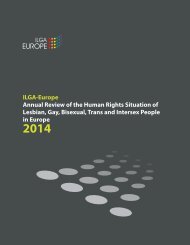Create successful ePaper yourself
Turn your PDF publications into a flip-book with our unique Google optimized e-Paper software.
„Ando gettovo rakhadyilas vi muro shavoro.<br />
(…) Aba azhukarnas ando vudar<br />
muro shavore Line les, me pe kodi gindyisardom<br />
ingren les ande institucija, thaj vi<br />
muri dej kodi phendas: ingerde les ande<br />
Nyíregyháza, ande institucija. Kanak avri<br />
slobodisardam, rodam les, thaj khanyikaj<br />
chi arakhlam les".<br />
M. M.-né<br />
Ande Kisvárda rakhadyilom 1931 sas marciush<br />
20. Phirdom ande shkola, nabut ke nas man<br />
papuchi. Numa zhikaj o krechiuno, baro jiv sas,<br />
thaj na zhanglam te zhas ande shkola ke opre sas<br />
ando gav. Purangles nashtig gelam ande shkola.<br />
Andal kotora sudas mange muri dej papuchi.<br />
Andar kotora. Andar le gonenge kotora shindas<br />
tele. Kade phende: bochkori. Kade gelom ande<br />
shkola.<br />
Cine kolyibi sas atunchi pe kodo than kaj le<br />
roma beshnas. Zurales chorre sas le roma. Me le<br />
papuchi chi na pinzhardom, numa atunchi<br />
kanak romnyi kerdyilom, chorre roma samas.<br />
Chi atunchi nas le romen butyi, chi akanak naj.<br />
Milajesa mure dadesa, thaj mura dasa kukurizo,<br />
kolompiri mezgerisardam. Thaj gele le romnye<br />
ando gav, kasht te shingren, thaj ando kaver gav,<br />
vajogi kernas. Kaj le barvale gazhe nashtig keresas<br />
butyi ke kothe numa le gazhe shaj kernas<br />
butyi. Le olavura o Gyuri, o Joska, o La ka tosi<br />
grasten kinnas-bikinnas. Kodol barvale sasle,<br />
shukar vurdonesa phirnas, thaj shukar khere sas<br />
pe lenge punro, shukar gada sas len, kade zhanas<br />
ando foro. Ande Debrecina, ande Nyiregyháza<br />
„Én a gettóba megszültem. (…) És már<br />
várták az ajtóba a gyereket.<br />
És elvették, és én azt hittem, hogy<br />
intézetbe viszik, meg anyám is azt<br />
mondta: elvitték Nyíregyházára,<br />
az intézetbe. Kerestük mindenütt,<br />
mikor kiszabadultunk.<br />
Nem tanáltuk sehol.”<br />
M. M.-né<br />
Ezerkilencszázharmincegy március 20-án szü -<br />
let tem Kisvárdába. Jártam iskolába, de nagyon<br />
kicsit, mert nem volt cipônk. Mindig karácso -<br />
nyig, mert nem volt cipônk. Nagy havak<br />
voltak, és nem tudtunk menni, mert fent volt az<br />
iskola. És mezítláb nem mehettünk az isko lába.<br />
Rongyból varrt nekem anyám papucsot.<br />
Rongyból. Ilyen zsákdarab volt, abból varrta.<br />
Úgy mondták: bocskor. Úgy mentem iskolába.<br />
Kis kunyhók voltak akkor a telepen, kicsi kis<br />
kunyhók. Nagyon szegény cigányok voltak. Én<br />
például a cipôt nem ismertem, csak mikor asszonnyá<br />
lettem, szegények voltunk nagyon.<br />
Akkor se volt munkahely a cigányoknak, úgy<br />
mint most. Nyáron a szüleimmel tallóztunk<br />
ten gerit, krumplit. Meg mentek az asszonyok<br />
házalni, fát vágtak a szomszédba, meg vályogot<br />
vetettek. Summásnak nem vették fel a cigá nyo -<br />
kat, ott magyar emberek voltak. Az oláh cigá -<br />
nyok, a lovász cigányok, a Gyuri Jóskáék, a<br />
Lakatosék, azok kereskedtek lovakkal. Azok<br />
gazdagok voltak, gyönyörû szekérrel jártak,<br />
szép csizma a lábukon, szép ruha, mentek vá -<br />
sároztak. Debrecen, Nyíregyháza, mindenfelé<br />
‘I gave birth in the ghetto. (…) And they<br />
were waiting for the child at the door. They<br />
took the baby away, and I thought they had<br />
taken the baby to foster home and my<br />
mother also said the baby was taken to the<br />
foster home in Nyíregyháza. When we got<br />
out, we were looking for her everywhere.<br />
But we could not find her.’<br />
Mrs. M. M.<br />
I was born on the 20th of March, 1931 in<br />
Kisvárda. I attended school but not for long<br />
because we did not have shoes. I always had to<br />
stop goimg to school at Christmas because we<br />
did not have shoes. And barefoot we could not<br />
go to school. My mother made a slipper out of<br />
clothes. Out of clothes. She sew it out of sackcloth.<br />
It was a kind of moccasin. I went to<br />
school in them.<br />
In the settlement there were small huts. And<br />
a lots of very poor Roma. I, for example, had<br />
not known shoes before I got married, we were<br />
so poor. Roma did not have jobs, just like these<br />
days. In summer we sorted corn or potatos. The<br />
other women used to peddle, they chopped<br />
wood in the neighbourhood and they made<br />
adobe. They were not taken as seasonal workers,<br />
Hungarians worked there. The Vlach Roma, the<br />
horse-keeping Roma, Jóska Gyuri’s and the<br />
Lakatos’s traded with horses. They were rich,<br />
they had a wonderful cart, beautiful boots on<br />
their feet, nice dress and they went to the market.<br />
To Debrecen, Nyír egyháza, they went to<br />
sell horses. Later, when the Russians came in,<br />
73



